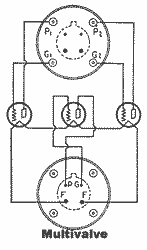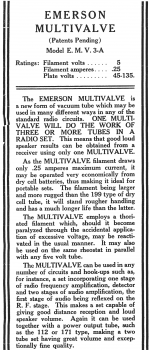| Description |
Alternative designation according to data sheet and tube box:
Model E.M.V. 3-A or EMC 3A.
On the tube itself, however, this designation is not to be found. On the known tubes, only "MULTIVALVE" is written in raised letters on the base of the tube.
Up to now, no operating point data or curves are known to us.
Measurements on 2 unused tubes showed the following average values for each of the 3 identical triode systems in the Multivalve:
Va = 100 V
Vg1 = 0 V --> Ia = 3.2 mA (variation 2.7 ... 3.8 mA)
Vg1 = -3 V --> Ia = 2.4 mA (variation 1.9 ... 2.9 mA)
S ≈ 0.3 mA/V (mutual conductance)
µ ≈ 8
S. Müller, 13.11.2021
The Emerson-Multivalve was also called the "Three-in-one". It was developed by Emerson Radval Corporation, New York, not to be confused with Emerson Radio & Phon. Corp., but the manufacturer was "Cleartron Vacuum Tube" which was near the back door of Emerson Radval. Both companies did the marketing.
The "Emerson Multivalve" has a special base with 4 pins and 4 screws. It is actually a UX-style 4-pin base (like for 01-A tubes) - which has an enlarged mould on top of the base with 4 binding posts for plate and grid of two triodes. The three heaters are in series. Only a few models did use this tube - for instance one by "Standard", the other by Clapp-Eastham. It was used mainly for self construction. The plates can be fed with 45 to 135 volts and the tube serves for detection, oscillation and AF amplification.
According to an article by Ray Bintliff in the AWA publication volume 14 (April 1997). "The February 1927 issue of Radio News carried a construction article for the Haynes DX-2 Multivalve receiver." He mentions also: "The famous Sir Oliver Lodge "N" circuit was also adapted to use the Multivalve tube. A construction article by the Precision Coil Co. was described in the June 1974 issue of the Old Timer's Bulletin. This circuit utilized a Multivalve tube as the detector and two stages of AF amplification. A Type 112 tube served as the audio output tube." And he lists the following: "The McGraw-Hill Radio Trade Catalog, dated February 1927, contains a catalog page for the Emerson Radval Corporation in which Radval listed "examples of modern circuits practically built around the Multivalve." In addition to the radios described above, Radval claimed that the following circuits employed Multivalve tubes: the Haynes and Cockaday Univalve Receiver, Doctor Lovejoy's Multivalve Receiver, Browning-Drake, and Mignon Mastertone Senior Single Control. Did Browning-Drake ever produce a radio that used a Multivalve tube? Did the Mignon ever see the light of day?"
Text in other
languages (may
differ)
|

Multivalve: RFJ
Roy Johnson
|
 Multivalve: KoBi
Multivalve: KoBi
Konrad Birkner † 12.08.2014
|
|

Multivalve: own collection
Peter den Boer † 2025
More ...
|
Quantity of Models at Radiomuseum.org with this tube (valve, valves, valvola, valvole, válvula, lampe):4
Collection of
|

